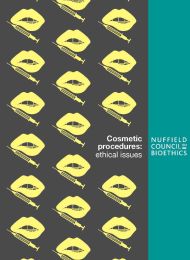Cosmetic procedures: ethical issues
Report
Published 22/06/2017

Ethical analysis
We believe that a key ethical concern with respect to the provision and use of cosmetic procedures is the role played by a commercially driven industry in a social context of significant dissatisfaction and distress about personal appearance. By developing invasive cosmetic procedures that are marketed in line with prevailing appearance ideals, the industry plays an important role in reinforcing those ideals. In doing so, it contributes to the public health harms associated with poor body image.
Such appearance ideals are a further source of concern where they feed existing negative and discriminatory attitudes with respect to factors such as age, gender, race, class, and disability.
These concerns are compounded by the fact that procedures are offered within an apparently trust-based context where users might assume high standards of professional conduct and integrity – but where, in practice, profit motives may dominate.
It is not possible to draw absolute and robust distinctions between cosmetic and therapeutic treatments, or between some cosmetic procedures and routine beauty treatments (see page 3). Nevertheless, there are clearly degrees to which the use of different procedures, in different circumstances, can contribute to public health and discriminatory harms, or may undermine relationships of trust between practitioners and users / patients.
It is important that people have the opportunity to make free, individual choices about the procedures that they might wish to consider. However, the social pressures that we have discussed have the potential to limit, rather than extend, the choices that individuals see as being open to them. We therefore propose an ethical approach that focuses on the wider social context in which cosmetic procedures are promoted, rather than on the decisions made by individuals within that context.
Demand and supply
We suggest an ethical approach to policy that includes two distinct elements, relating to ‘demand’ and ‘supply’, respectively. On the demand side, we challenge the promotion of potentially damaging appearance ideals, and the pressure that this exerts on people to meet them (thereby stimulating demand). On the supply side, we explore how a more ethical encounter between users and practitioners could be fostered, particularly with respect to the use of these procedures by children and young people.
Ethical questions arising on the demand side include the nature and extent of public health responsibilities of governments, and the corporate social responsibilities of industry. We argue that governments’ responsibilities include providing the conditions in which people can live healthy lives – including tackling the way in which unhealthy or discriminatory appearance ideals are promoted. Industry similarly has a responsibility to take into account the interests of society as a whole, alongside its own interests.
Ethical questions arising on the supply side include consideration of the roles and responsibilities both of cosmetic providers, and of individual practitioners. We explore, in particular, how practitioners can ensure that the way that they practise does not make them ‘part of the problem’: for example by ensuring that they act always with users’ / patients’ best interests in view, and not in the role of a salesperson. Similar responsibilities arise for providers, for example with respect to maintaining clear distinctions between sales staff and practitioners, and ensuring that no financial commitments are asked of users before a firm decision has been made as part of a two-stage consent process. High standards of safety and governance for the industry as a whole, covering practitioners, products, and premises, are essential for any encounter between potential users and practitioners to be conducted on an ethical basis.

Share